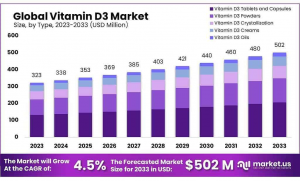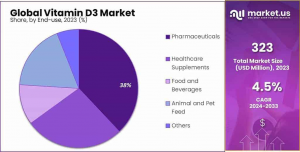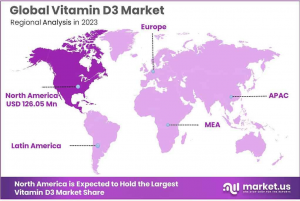Vitamin D3 Market Expected To Reach USD 502 Million by 2033 | 61.5% Bone Health Share
Vitamin D3 market size is expected to be worth around USD 502 Million by 2033, from USD 323 Million in 2023, growing at a CAGR of 4.5% from 2023 to 2033
The Asia-Pacific region dominated the Vitamin D3 market, securing a substantial 43.3% market share. The market is projected to reach USD 31.4 billion by the end of the forecast period.”
NEW YORK, NY, UNITED STATES, January 27, 2025 /EINPresswire.com/ -- The global Vitamin D3 Market is witnessing substantial growth, driven by the increasing awareness regarding its health benefits, rising prevalence of vitamin D deficiency, and expanding applications across various industries, including pharmaceuticals, food and beverages, and animal feed. Vitamin D3, also known as cholecalciferol, plays a crucial role in calcium absorption, bone health, immune function, and overall well-being. With growing concerns over deficiencies, particularly in regions with limited sun exposure, demand for Vitamin D3 supplements has surged significantly. Additionally, the expanding geriatric population and increasing incidence of osteoporosis and other bone-related disorders have further fueled market growth. Governments and health organizations worldwide are actively promoting Vitamin D3 consumption, creating a favorable regulatory environment that supports market expansion.— Tajammul Pangarkar
The competitive, with major manufacturers focusing on expanding production capacities, enhancing product formulations, and ensuring high-quality standards to meet stringent regulatory guidelines. China remains a dominant player in Vitamin D3 production, supplying a significant share of the global demand, while North America and Europe are major consumers due to the high prevalence of vitamin D deficiencies. The industry also benefits from continuous advancements in extraction and synthesis technologies, leading to improved product efficiency, stability, and bioavailability. However, fluctuations in raw material prices, supply chain disruptions, and regulatory challenges pose significant hurdles for manufacturers operating in this space.
Several factors are driving the growth of the Vitamin D3 market, including the increasing trend of preventive healthcare and dietary supplementation. Consumers are becoming more proactive about their health, leading to a surge in demand for vitamin-enriched functional foods and dietary supplements. The rising vegan population has also contributed to the growth of plant-based and synthetic Vitamin D3 alternatives, as traditional sources are primarily derived from lanolin (sheep’s wool) or fish oil. Furthermore, the expanding application of Vitamin D3 in animal nutrition, particularly in poultry and livestock feed, has augmented demand, as it plays a critical role in animal growth, reproduction, and immune function. The pharmaceutical sector remains a key consumer, with Vitamin D3 being widely used in formulations targeting bone health, cardiovascular diseases, and immune-related disorders.
Future growth opportunities in the Vitamin D3 market are vast, with increasing research and development initiatives focusing on enhancing product formulations and expanding application areas. The integration of microencapsulation and nanotechnology in Vitamin D3 formulations is gaining traction, as it improves stability and bioavailability, allowing for innovative product development. The growing demand for personalized nutrition and fortified foods presents lucrative prospects for market players, as consumers seek customized solutions to address specific health needs. Additionally, emerging markets in Asia-Pacific and Latin America offer untapped growth potential, driven by rising disposable incomes, improving healthcare infrastructure, and increasing awareness regarding nutritional deficiencies. Sustainable and vegan-friendly alternatives are expected to gain momentum, as manufacturers focus on ethical sourcing and clean-label products to cater to evolving consumer preferences.
👉 𝐅𝐨𝐫 𝐚 𝐝𝐞𝐞𝐩𝐞𝐫 𝐮𝐧𝐝𝐞𝐫𝐬𝐭𝐚𝐧𝐝𝐢𝐧𝐠, 𝐜𝐥𝐢𝐜𝐤 𝐨𝐧 𝐭𝐡𝐞 𝐬𝐚𝐦𝐩𝐥𝐞 𝐫𝐞𝐩𝐨𝐫𝐭 𝐥𝐢𝐧𝐤: https://market.us/report/vitamin-d3-market/free-sample/
Key Takeaways
• Market Growth: The vitamin D3 market is to reach USD 502 million by 2033, growing at 4.5% CAGR from USD 323 million in 2023.
• Primary Application: The bone health segment dominates, capturing 61.5% market share in 2023 due to Vitamin D3’s role in calcium absorption.
• Diverse Industries: Pharmaceuticals lead with 38.9% market share in 2023, followed by healthcare supplements and food and beverages.
• Distribution Channels: Pharmaceutical stores hold 38.8% market share in 2023, followed by hypermarkets and supermarkets, reflecting consumer trust and convenience.
Vitamin D3 Top Trends
1. Rising Demand for Fortified Foods and Beverages: Consumers are increasingly seeking foods and drinks enriched with Vitamin D3 to address nutritional deficiencies. This trend is particularly strong in regions with limited sunlight exposure, where individuals may lack sufficient natural Vitamin D3 synthesis. Manufacturers are responding by introducing a variety of fortified products to meet this growing demand.
2. Advancements in Supplement Delivery Methods: Innovations in supplement delivery, such as the development of vitamin patches, are gaining attention. These patches offer an alternative for individuals who have difficulty swallowing pills, providing a convenient method to receive their daily Vitamin D3 intake. However, the effectiveness of transdermal vitamin patches is still under evaluation, with some studies questioning their efficacy.
3. Increased Focus on Personalized Nutrition: There's a growing emphasis on personalized nutrition, with consumers seeking tailored Vitamin D3 supplements that cater to their specific health needs. This approach considers factors like age, gender, lifestyle, and existing health conditions, leading to more customized and effective supplementation strategies.
4. Expansion in Animal Nutrition Applications: Vitamin D3 is increasingly being incorporated into animal feed to enhance livestock health and productivity. This practice not only supports animal well-being but also improves the nutritional quality of animal-derived food products, benefiting human consumers.
5. Growth in Vegan and Plant-Based Vitamin D3 Sources: With the rise of plant-based diets, there's an increasing demand for vegan-friendly Vitamin D3 supplements. Traditionally sourced from animal products, manufacturers are now exploring plant-based alternatives, such as lichen-derived Vitamin D3, to cater to this expanding market segment.
Key Market Segments
By Type
In 2023, Vitamin D3 Tablets and Capsules dominated the market, capturing over 41.3% share. Their popularity stems from the convenience and precision of dosage, making them the preferred choice for consumers seeking easy-to-use supplements. The widespread availability of these forms in pharmacies, health stores, and online platforms further strengthens their market position.
Vitamin D3 Powders followed, appealing to a diverse consumer base due to their versatility. They can be easily incorporated into daily diets through smoothies, juices, or foods, providing an alternative for those who prefer not to take pills. Their adaptability to varying dosage needs has driven growing acceptance among families and individuals focused on personalized nutrition.
By Application
In 2023, Bone Health held a dominant market share of 61.5%, driven by Vitamin D3’s essential role in calcium absorption and bone mineralization. Its significance in preventing osteoporosis, rickets, and other bone-related disorders has led to widespread consumption, particularly among aging populations and individuals with calcium deficiencies. Rising awareness of bone health has reinforced the demand for Vitamin D3 in this application.
Brain Health emerged as another key segment, with growing research highlighting Vitamin D3’s impact on cognitive function and mental well-being. Consumers are increasingly adopting Vitamin D3 supplements as a preventive measure against depression and cognitive decline. The trend reflects a broader shift towards proactive mental health management through dietary supplementation.
By End-Use
In 2023, Pharmaceuticals led the Vitamin D3 market with a 38.9% share, driven by its widespread use in medical treatments and preventive healthcare. Its role in addressing bone disorders, immune deficiencies, and cardiovascular health has established it as a vital component in pharmaceutical formulations. The trust in pharmaceutical-grade products for efficacy and safety has significantly contributed to this segment’s dominance.
Healthcare Supplements followed closely, benefiting from growing consumer awareness and proactive health management. With more individuals incorporating supplements into their daily routines for overall well-being, Vitamin D3 has become a fundamental ingredient in maintaining optimal health. This segment continues to expand as consumers increasingly prioritize nutrition-based health solutions.
By Distribution Channels
In 2023, Pharmaceutical Stores led the market, capturing more than 38.8% share, owing to consumer trust in professional healthcare advice and the reliability of pharmaceutical-grade supplements. These stores serve as a primary source for Vitamin D3 products, ensuring accessibility alongside guidance from pharmacists, which enhances consumer confidence in purchasing decisions.
Hypermarkets & Supermarkets followed as a key distribution channel, capitalizing on high consumer footfall and one-stop shopping convenience. Their broad retail network and competitive pricing make them an attractive choice for consumers looking for affordability and variety in Vitamin D3 supplementation.
👉 𝐁𝐮𝐲 𝐓𝐡𝐞 𝐂𝐨𝐦𝐩𝐥𝐞𝐭𝐞 𝐑𝐞𝐩𝐨𝐫𝐭 𝐭𝐨 𝐫𝐞𝐚𝐝 𝐭𝐡𝐞 𝐚𝐧𝐚𝐥𝐲𝐳𝐞𝐝 𝐬𝐭𝐫𝐚𝐭𝐞𝐠𝐢𝐞𝐬 𝐆𝐞𝐭 𝐃𝐢𝐬𝐜𝐨𝐮𝐧𝐭𝐬 𝐨𝐟 𝐔𝐩 𝐭𝐨 𝟑𝟎%! https://market.us/purchase-report/?report_id=17287
Key Market Segments List
By Type
• Vitamin D3 Tablets and Capsules
• Vitamin D3 Powders
• Vitamin D3 Crystallization
• Vitamin D3 Creams
• Vitamin D3 Oils
By Application
• Bone Health
• Brain Health
• Weight Management Products
• Others
By End-use
• Pharmaceuticals
• Healthcare Supplements
• Food and Beverages
• Animal and Pet Feed
• Others
By Distribution Channels
• Pharmaceutical Stores
• Hypermarkets & Supermarkets
• Food specialty stores
• Others
Regional Analysis
The Asia-Pacific region dominated the Vitamin D3 market, securing a substantial 43.3% market share. The market is projected to reach USD 31.4 billion by the end of the forecast period, driven by increasing adoption across pharmaceuticals, nutraceuticals, and food and beverage industries. Countries such as China, India, Japan, and South Korea are at the forefront, experiencing heightened Vitamin D3 consumption due to rising health awareness and government initiatives promoting supplementation.
In North America, the market continues to grow steadily, fueled by a strong consumer base emphasizing preventive healthcare and dietary supplementation. The demand for Vitamin D3 in pharmaceuticals, fortified foods, and weight management products is on the rise, supported by research-driven consumer education and expanding product offerings. The region’s focus on innovation and quality assurance sustains its market expansion.
Regulations On the Vitamin D3 Market
1. Standardization of Dosage and Forms: Regulatory bodies establish standardized dosages and forms of Vitamin D3 to maintain consistency and safety. For instance, in India, the Indian Council of Medical Research (ICMR) recommends a daily supplement of 400 IU of Vitamin D for individuals with minimal sun exposure.
2. Quality Control and Manufacturing Practices: Manufacturers of Vitamin D3 supplements must adhere to Good Manufacturing Practices (GMP) to ensure product quality and safety. This includes stringent quality control measures during production, testing for potency, purity, and absence of contaminants.
3. Labeling and Health Claims: Regulations require clear labeling of Vitamin D3 products, including dosage, ingredients, and health claims. In India, the Food Safety and Standards Authority of India (FSSAI) oversees the labeling of nutraceuticals, ensuring that claims are substantiated and do not mislead consumers.
4. Fortification Standards: In some regions, regulations permit the fortification of foods with Vitamin D3 to address deficiencies. For example, India has allowed the fortification of certain foods with Vitamin D3, aiming to improve public health nutrition.
5. Safety and Toxicity Guidelines: Regulatory agencies set upper intake levels for Vitamin D3 to prevent toxicity. In India, the FSSAI has issued guidelines to prevent Vitamin D overdose, emphasizing the importance of adhering to recommended dosages.
Key Players
• American Way Cooperation
• BASF SE
• Dishman Carbogen Amcis Limited.
• Fermenta Biotech Limited
• GSK plc
• Koninklijke DSM N.V.
• Kraft Foods Group.
• LycoRed Ltd.
• Pfizer Inc.
• Teva Pharmaceutical Industries Limited
• Zhejiang Garden Bio-chemical High-tech Co., Ltd.
• Zhejiang NHU Company Ltd
Conclusion
The Vitamin D3 Market is expected to continue its upward trajectory as consumers become more proactive about their health and wellness. As awareness of its benefits for bone health, immune function, and overall well-being grows, the demand for Vitamin D3 supplements is likely to rise across multiple sectors, including pharmaceuticals, food and beverages, and animal nutrition. Innovation in delivery methods, such as powders, oils, and plant-based alternatives, will further diversify product offerings, catering to evolving consumer preferences. Additionally, regulatory frameworks and quality standards will continue to play a critical role in maintaining product safety and efficacy. Overall, the future of the Vitamin D3 market looks promising, driven by increasing health-consciousness, new product innovations, and expanding applications across various industries.
Lawrence John
Prudour
+91 91308 55334
Lawrence@prudour.com
Legal Disclaimer:
EIN Presswire provides this news content "as is" without warranty of any kind. We do not accept any responsibility or liability for the accuracy, content, images, videos, licenses, completeness, legality, or reliability of the information contained in this article. If you have any complaints or copyright issues related to this article, kindly contact the author above.



